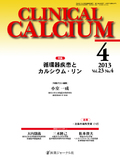Japanese
English
- 有料閲覧
- Abstract 文献概要
- 1ページ目 Look Inside
- 参考文献 Reference
心筋の興奮収縮連関においてカルシウム(Ca2+)は必要不可欠であり,心筋の収縮・弛緩をつかさどる重要なイオンである。心不全は心筋の収縮・弛緩の障害を基盤とする症候群であり,心筋の興奮収縮連関および心筋細胞内Ca2+動態の異常が密接に関わっている。つまり,心筋細胞内のCa2+貯蔵庫である心筋筋小胞体(SR)におけるCa2+制御蛋白の構造的および機能的変化により,SR内のCa2+濃度が減少し,細胞内Ca2+過負荷をきたした結果,心筋障害をきたす。なかでもSR のCa2+放出チャネルであるリアノジン受容体(RyR2)の機能異常は心不全のみならず不整脈誘発の直接の原因となり,RyR2を安定化させることによる細胞内Ca2+動態の改善は心不全,不整脈の治療にもつながることが判明しつつある。
Alterations in Excitation-Contraction coupling have recently been shown to play a crucial role in the pathogenesis of heart failure(HF). In failing hearts, abnormalities of neurohormonal mechanisms, which were included chronic activation of the sympathetic nervous system or of the renin-angiotensin system result in structural and functional changes in the calcium(Ca2+)regulatory proteins. These changes include the decreased sarcoplasmic reticulum(SR)load, which could be caused by reduced SR Ca2+-ATPase(SERCA2A)function and increased SR Ca2+ leak via cardiac ryanodine receptor(RyR2),a functional defect in L-type Ca2+ channel and activation of the reversal mode of Na+/Ca2+ exchanger. The abnormal regulation of intracellular Ca2+ affects troponin C binding and actin-myosin cross bridging and modulates post signaling pathway, which in turn contributes to the contractile dysfunction of hearts and hence to the progression of HF. Moreover, diastolic Ca2+ leak may develop delayed after depolarization and triggered activity as a substrate for lethal arrhythmia and sudden cardiac death. In this review, we focus on the underlying mechanism of defective Ca2+ regulation in HF and on the possibility of proceeding to clinical application as a new treatment for HF by targeting Ca2+ regulatory proteins.



